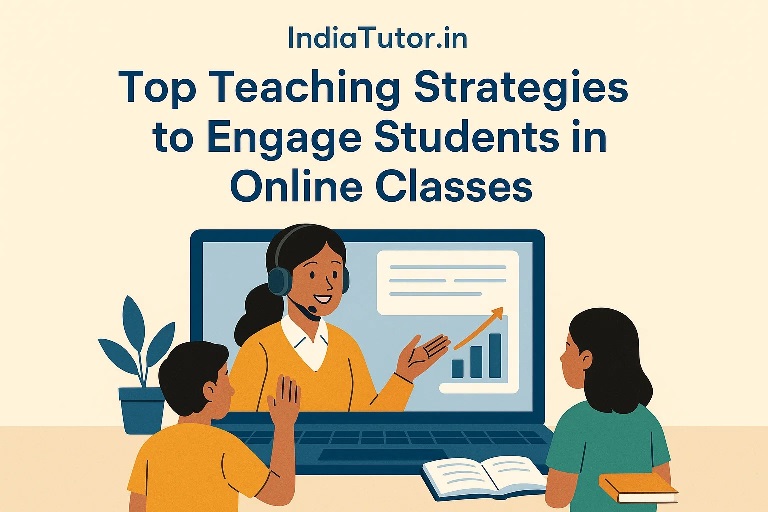Online classes have become the new normal for students and teachers across India. While technology has made learning accessible from anywhere, it has also brought new challenges—especially in keeping students engaged. Attention spans are shrinking, distractions are increasing, and online fatigue is real. So how can we, as teachers, make sure our students stay interested, involved, and active during virtual lessons?
Here are some of the most effective teaching strategies to keep your students engaged in online classes, backed by research, real-world examples, and practical tips.
1. Start with a Warm Welcome and Clear Objective
Begin every class by greeting your students by name and setting the tone with a friendly, positive vibe. According to a 2022 study by EdTechReview, teachers who spent the first five minutes on icebreakers or informal chats saw a 25 percent increase in student participation during the rest of the session.
Make your goals for the session clear. For example, instead of saying “Today we’ll study fractions,” try “By the end of today’s class, you’ll be able to solve real-life fraction problems, like cutting a pizza or sharing chocolates.”
2. Use the 10-Minute Rule for Attention Span
Studies show that student attention tends to drop sharply after 10–15 minutes. Try breaking your lecture into small chunks. Teach for 10 minutes, then follow it up with a quiz, question, poll, or short discussion.
For instance, after explaining a science concept like photosynthesis, you could ask: “Can you give one example of where you see this happening in nature around you?” This keeps their minds active and avoids passive listening.
3. Add Visuals and Real-Life Examples
Use diagrams, animations, whiteboards, and real-world examples as often as possible. If you’re teaching about gravity, drop a pen on camera. If you’re explaining percentages, show how discounts work in real shopping.
A report from UNESCO (2023) found that visual learning aids improved concept clarity by over 30 percent in online learners aged 10–16.
4. Encourage Two-Way Communication
Engagement increases when students feel heard. Encourage them to unmute and speak, type in the chat, or even raise virtual hands. Use tools like Google Jamboard, Padlet, or even a simple shared Google Doc to let them co-create mind maps or answer questions collaboratively.
You can also assign “student teachers” who explain a part of the lesson to others. Peer teaching is known to boost retention and build confidence.
5. Include Short Activities and Brain Breaks
Attention fatigue is real. A simple two-minute game, riddle, or stretch break midway through class can refresh young minds. Educational games like Kahoot! or quizzes through Quizizz are very effective.
According to a 2021 survey by Teachmint, teachers who used interactive tools reported a 40 percent higher retention rate among students.
6. Use Flipped Classroom Strategy
In a flipped classroom, students watch or read lessons at home (through pre-recorded videos or materials), and class time is used for discussions, problem-solving, or revision.
This works well in online settings, especially with older students. You can send a YouTube video or worksheet beforehand and then use the live class for interactive learning.
7. Personalize and Praise
Every student learns differently. Try to identify students who are shy, those who need more help, or those who love challenges. Adjust your tone and pace accordingly.
Also, don’t underestimate the power of a genuine “Well done!” or “I loved how you explained that.” Positive feedback builds motivation.
8. Track Progress and Keep Parents in the Loop
Share regular updates on student progress through emails or short messages. Create weekly or monthly mini-reports with key highlights. This not only keeps parents engaged but also motivates students.
Many teachers on IndiaTutor.in have seen improved performance simply by conducting a 10-minute monthly review call with parents.
9. Keep Tech Simple and Stable
Too many tools can confuse students and create delays. Stick to a few reliable platforms. Make sure you have a backup plan in case of a power cut or internet issue. If possible, record your classes for students to revise later.
Tip: Always test your tools before class starts. Having a stable internet connection and a clear audio setup makes a big difference in how students perceive your teaching.
10. Reflect and Improve Continuously
After every class, take five minutes to think: What worked? What didn’t? Did most students participate? Was the class too fast or too slow?
As teachers, we’re always learning too. Ask for feedback from students occasionally, either anonymously or in group chats.
My Thoughts
Engaging students online is a skill that improves with time, patience, and effort. The key is to make students feel seen, heard, and excited to learn. Small changes in your teaching strategy can lead to big improvements in student attention and performance.
At IndiaTutor.in, we believe in empowering teachers with the right tools, support, and exposure to succeed in this new era of digital education. Whether you’re a new tutor or a seasoned educator, these strategies will help you create more meaningful and impactful online classes.
By Nidhi Mehta, Founder – IndiaTutor.in

